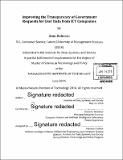Improving the transparency of government requests for user data from ICT companies
Author(s)
Rahman, Amn
DownloadFull printable version (15.06Mb)
Other Contributors
Technology and Policy Program.
Advisor
Daniel J. Weitzner.
Terms of use
Metadata
Show full item recordAbstract
In 1968, the US Congress enacted a detailed list of requirements for transparency reporting of wiretaps but with subsequent surveillance statutes with minimal reporting requirements and rapidly evolving Internet technologies, the gap in surveillance transparency grew. The Snowden disclosures in 2013 provided a peek into the surveillance landscape and the central role of ICT companies in fostering it. While attempting to salvage their tarnished reputations and encourage public discussion, several companies began to see an incentive in publishing 'transparency reports', providing statistics on user data requested by the government. Since then, publishing these reports has become a norm in the industry but the reports provide little benefit in bridging the transparency gap. The varying formats, definitions and levels of granularity in the reports and the absence of a governance framework in the industry, prevent the reports from becoming useful tools for stakeholders wishing to inform policy decisions. In addition, new technologies, modern surveillance techniques, and evolving business models have created a set of transparency requirements that is markedly different from the initial set of requirements established under the US Wiretap Act. This thesis identifies the missing elements in the current transparency reports while providing a detailed list of necessary features. In addition, it uncovers the incentives that can be leveraged using available tools to encourage better reporting practices and suggests technical, legal and policy solutions so that transparency reporting may become a useful public policy tool rather than a ritualistic practice.
Description
Thesis: S.M. in Technology and Policy, Massachusetts Institute of Technology, School of Engineering, Institute for Data, Systems, and Society, Technology and Policy Program, 2016. Cataloged from PDF version of thesis. Includes bibliographical references (pages 96-107).
Date issued
2016Department
Massachusetts Institute of Technology. Engineering Systems Division; Massachusetts Institute of Technology. Institute for Data, Systems, and Society; Technology and Policy ProgramPublisher
Massachusetts Institute of Technology
Keywords
Institute for Data, Systems, and Society., Engineering Systems Division., Technology and Policy Program.